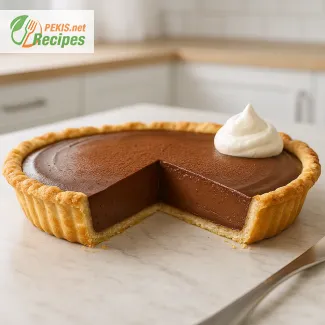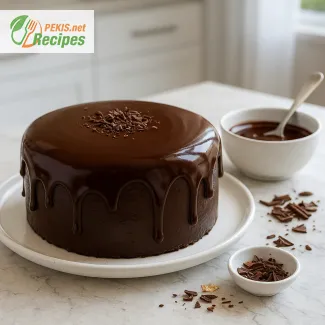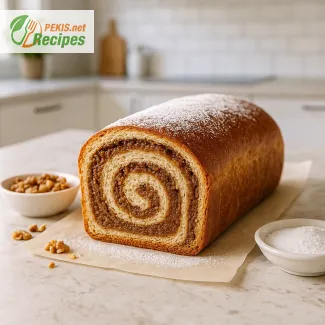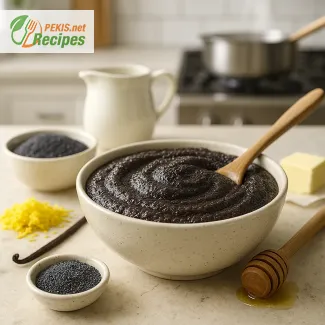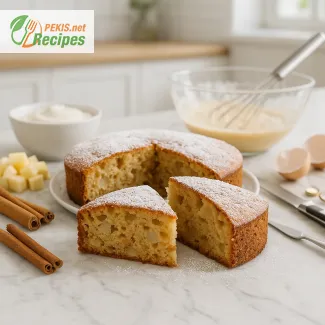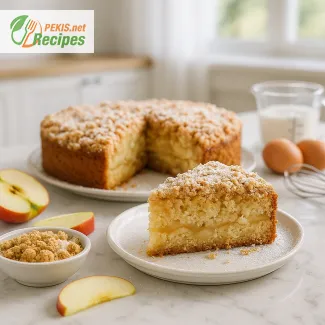
Traditional Romanian Pasca Cake – A Symbolic Easter Delight with Creamy Cheese and Raisins
Discover the sweet legacy behind this festive Romanian Easter treat
Among the cherished culinary traditions of Eastern Europe, few desserts are as richly symbolic and irresistibly delicious as Romanian Pasca. This festive cake, traditionally served during Orthodox Easter, brings together the warmth of homemade baking, the depth of religious symbolism, and the creamy indulgence of sweet cheese and raisins into a harmonious, celebratory masterpiece. With its soft yeast dough, fragrant with citrus zest and vanilla, and its luscious cheese filling often enriched with eggs, sour cream, and rum-soaked raisins, Pasca holds a beloved place on the Easter table in Romanian homes and beyond.
Pasca isn’t just a dessert; it’s a cultural icon. Often baked only once a year to honor the Resurrection, its round shape is said to symbolize eternity and perfection, while the cross-shaped dough decoration across the top represents faith and the sacrifice of Christ. Its preparation is deeply rooted in tradition, passed down through generations, where the act of making Pasca becomes a ritual in itself—often prepared on Holy Saturday and blessed in church on Easter morning.
The base of the cake is a lightly sweetened yeast dough, similar to brioche but lighter, providing a pillowy foundation for the rich cheese filling. The heart of Pasca lies in its center—a creamy mixture of fresh farmer’s cheese (or ricotta), eggs, sugar, and golden raisins, often scented with lemon zest and vanilla. Some regional variations also include a hint of rum, orange peel, or even semolina, offering delightful textures and subtle layers of flavor.
For many Romanian families, the process of preparing Pasca starts days in advance, with meticulous attention to choosing the best ingredients, activating the yeast perfectly, kneading the dough to the right consistency, and ensuring that the cheese mixture is smooth and not too wet. In some homes, you’ll find sweet Pasca made with a fully enclosed cheese filling, while in others, the filling is exposed and set beautifully within a braided dough border, often adorned with decorative dough crosses or other festive symbols.
There’s something profoundly comforting about slicing into a freshly baked Pasca. The aroma of vanilla, lemon zest, and baked bread fills the air, while the creamy filling contrasts beautifully with the tender, golden crust. Served slightly warm or at room temperature, often dusted with powdered sugar, it pairs wonderfully with a cup of coffee or tea during Easter breakfast or as a dessert following the Easter feast.
Though deeply Romanian in origin, Pasca resonates with universal themes—renewal, tradition, family, and celebration. It invites us to slow down, gather together, and savor not only the flavors of the season but also the spiritual and cultural richness that this unique dessert embodies. Whether you're baking Pasca for the first time or continuing a long-standing family tradition, this cake offers a beautiful way to connect with your heritage, celebrate the joy of Easter, and indulge in a dessert that truly nourishes both body and soul.
Its distinct blend of creamy sweetness, light yeast cake, and fragrant citrus undertones make it unlike any other Easter dessert. And though it's tied to a specific time of year, its appeal is timeless—inviting bakers around the world to explore the beauty of Romanian holiday baking.
In the following sections, you’ll learn how to recreate this iconic cake at home with step-by-step instructions, understand what makes an authentic Pasca, and discover how small regional differences can add exciting variations to the basic recipe. Prepare to bring a piece of Romanian Easter tradition into your own kitchen, and celebrate the season with this unforgettable sweet cheese Easter cake.
- Activate the yeast: Warm the milk (not hot) to about 37°C / 98°F. Dissolve 1 tablespoon of the sugar in it, then add the fresh yeast. Let it sit for 10–15 minutes until frothy.
- Prepare the dough: In a large bowl, sift the flour. Make a well in the center and pour in the yeast mixture. Add egg yolks, melted butter (cooled slightly), remaining sugar, vanilla extract, lemon zest, orange zest, and salt. Mix and knead until a smooth, elastic dough forms (about 10 minutes). Cover and let rise in a warm place until doubled in size (about 1 hour).
- Prepare the filling: While the dough is rising, mix the cheese with sour cream, sugar, eggs, vanilla, semolina, lemon zest, and raisins. Add a splash of rum if using. Stir until smooth and creamy. Set aside.
- Assemble the Pasca: Once risen, divide the dough into two parts: ¾ for the base and ¼ for decoration. Roll the larger part into a circle and place it in a greased 26 cm (10-inch) springform pan, letting the edges come up the sides slightly. Pour in the cheese filling and level it.
- Decorate: With the remaining dough, roll two thin ropes and shape them into a cross or braid. Place gently over the filling. Let the assembled cake rise for another 20 minutes.
- Bake: Preheat the oven to 170°C (340°F). Brush the top with beaten egg yolk and bake for 40–45 minutes, or until golden brown and set in the center. If browning too quickly, cover loosely with foil.
- Cool and serve: Let the Pasca cool completely in the pan before removing. Dust with powdered sugar before serving if desired.
Enhancing Your Romanian Pasca – Tips and Tricks for a Perfectly Creamy Easter Cake
Mastering the Pasca: How to Adjust Ingredients and Techniques for a Better Outcome
Romanian Pasca is a classic Easter dessert that combines rich traditions with a delightful balance of textures and flavors. However, no recipe is ever "perfect" until it is tailored to your preferences. Whether you're a novice baker or a seasoned expert, there are always ways to elevate the quality of this beloved sweet cheese cake. By making small tweaks to ingredients or techniques, you can enhance the overall flavor, texture, and appearance of the Pasca, turning it into a showstopper for any occasion. In this article, we will explore different methods to improve the Romanian Pasca recipe, focusing on ingredient substitutions, flavor enhancements, healthier alternatives, and common mistakes to avoid.
Ingredient Substitutions and How They Impact Flavor
One of the easiest ways to improve the Pasca recipe is by experimenting with ingredient substitutions. Each change you make will slightly alter the flavor profile of the cake, and understanding these variations can help you perfect the recipe to suit your tastes.
1. Swap the cheese
The traditional Pasca filling is made using farmer's cheese or ricotta, which gives it a creamy and slightly tangy taste. However, if you want a smoother texture, you can replace the cheese with cream cheese or mascarpone. These cheeses add a luxurious, rich flavor and will make your filling even creamier. On the other hand, if you prefer a firmer filling, opt for cottage cheese instead. This alternative will give the cake a more textured filling while still maintaining its deliciously sweet flavor.
2. Experiment with sweeteners
Instead of using refined white sugar, you can make your Pasca healthier by replacing it with honey, maple syrup, or even coconut sugar. Honey or maple syrup can impart a lovely floral or caramelized flavor to the filling, adding depth. If you're looking for a refined sugar-free option, stevia or monk fruit sweetener can also be used, although these might slightly change the flavor due to their distinct aftertastes.
3. Add flavor-enhancing spices
Spices such as cinnamon, nutmeg, or cardamom can subtly elevate the flavor of the Pasca. A pinch of cinnamon in the dough or filling can enhance the warm, cozy aromas of the cake. For a more exotic twist, try adding cardamom or cloves. Just be careful to use these spices sparingly, as they can overpower the delicate flavors of the cheese and raisins.
4. Infuse the dough with zest
For a brighter, more fragrant twist, consider adding extra lemon or orange zest to the dough. While traditional Pasca already includes lemon zest, a more generous amount or adding orange zest can provide a more citrus-forward flavor that complements the sweetness of the filling. You can also experiment with vanilla beans for a richer, more aromatic dough.
Making Pasca Healthier: Healthier Alternatives and Substitutions
If you want to make your Pasca a bit lighter without sacrificing flavor, there are a few healthier alternatives that can help:
1. Use whole grain flour
Instead of regular white flour, try using whole wheat flour or a mix of whole wheat and all-purpose flour. This change will introduce a slightly nutty flavor and make the dough more nutritious. Keep in mind that whole wheat flour may result in a denser texture, so you might need to adjust the liquid ratio slightly.
2. Choose healthier fats
Pasca traditionally uses butter for its dough, but you can substitute it with olive oil, coconut oil, or even avocado oil. These oils not only provide healthy fats but also add a subtle flavor profile that complements the sweetness of the cake. If you're looking for an even lighter option, unsweetened applesauce can replace some of the butter to reduce fat content while maintaining moisture.
3. Opt for low-fat dairy
To cut down on calories, you can use low-fat versions of the dairy ingredients such as sour cream, cheese, and milk. If you're aiming for a dairy-free option, use plant-based alternatives like coconut milk, almond yogurt, and dairy-free cream cheese. While the texture may slightly change, these alternatives will still provide the creaminess needed for the filling.
Why Homemade Pasca is Always Better
While store-bought versions of Pasca may be convenient, there are several reasons why homemade Pasca is always a better option. When you make Pasca at home, you control the quality of ingredients, ensuring that everything is fresh and natural. This also allows you to avoid unnecessary preservatives or artificial flavorings that are often present in store-bought cakes.
Additionally, making Pasca from scratch allows you to adjust the sweetness to your liking. Many commercial versions can be overly sweet, which might mask the delicate flavors of the cheese and raisins. By making it at home, you can achieve the perfect balance of sweetness and tanginess that suits your preferences.
Another benefit of homemade Pasca is the ability to customize the size. If you're hosting a small family gathering, you can make a smaller cake, or for a larger event, you can scale up the recipe. Homemade Pasca also offers the satisfaction of sharing something you’ve baked yourself, making it a more personal and meaningful experience.
Common Mistakes to Avoid When Making Pasca
When baking Pasca, there are several common mistakes that can lead to unsatisfactory results. Here’s what to watch out for:
1. Overmixing the dough
When kneading the dough, it’s important not to overwork it. Overmixing the dough can lead to a tough texture. Make sure to knead only until the dough is smooth and elastic, then allow it to rise properly. If the dough is too dense, it will affect the lightness of the finished cake.
2. Not allowing enough rising time
Pasca dough relies on yeast, so it’s crucial to give it adequate time to rise. Be patient and allow the dough to double in size before proceeding to the next step. Skipping this step can result in a dense, heavy texture that’s far from the ideal airy crumb of a perfect Pasca.
3. Incorrect oven temperature
The Pasca should be baked at a moderate temperature. If the oven is too hot, the top may brown too quickly while the inside remains raw. On the other hand, baking at too low of a temperature can lead to a dry cake. Ensure that your oven is preheated to the proper temperature, and consider checking with a thermometer for more accuracy.
4. Not preparing the filling properly
One common issue with the cheese filling is excess moisture. If the cheese mixture is too runny, it can cause the filling to spill over during baking or make the cake soggy. To avoid this, make sure to drain any excess liquid from the cheese and use a thickening agent like semolina or cornstarch if necessary.
Making the Perfect Pasca
Making the perfect Romanian Pasca takes practice, but with the right techniques and ingredients, anyone can achieve a soft, creamy, and flavorful cake that becomes the highlight of any Easter celebration. By adjusting the ingredients to suit your preferences, making healthy substitutions, and avoiding common mistakes, you can create a version of Pasca that’s truly exceptional. Whether you're experimenting with different cheeses, adding spices for depth, or simply perfecting your dough, each step you take brings you closer to making a cake that will be cherished for years to come.
Remember, the key to improving any traditional recipe is personalization. So don’t be afraid to experiment, and enjoy the process of creating something deliciously unique for yourself and your loved ones!
- Gluten (wheat flour)
- Eggs
- Dairy (cheese, sour cream, butter, milk)
Gluten-free or allergen-free substitutes:
- Use certified gluten-free flour blend with 1 tsp xanthan gum instead of wheat flour.
- Replace dairy with plant-based versions (e.g., almond milk, vegan butter, dairy-free cream cheese).
- Use flax eggs (1 tbsp ground flaxseed + 3 tbsp water per egg) in place of eggs.
- Vitamin A: 300 µg – supports vision and immune function
- Vitamin B2 (Riboflavin): 0.4 mg – aids energy production
- Calcium: 150 mg – supports bones and teeth
- Phosphorus: 180 mg – vital for cell function and bone health
- Iron: 1.5 mg – supports oxygen transport
- Magnesium: 25 mg – helps muscle and nerve function
- Potassium: 160 mg – regulates blood pressure
- Flavonoids (from raisins and citrus zest): 40 mg – support heart health and reduce inflammation
- Phenolic compounds: 30 mg – help neutralize free radicals and protect cells from damage
